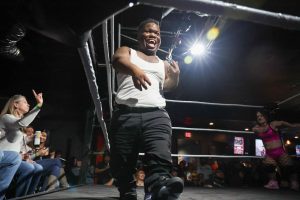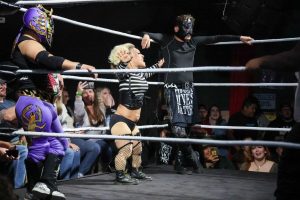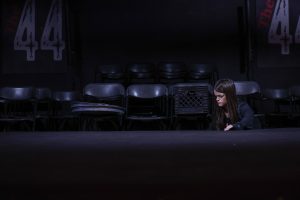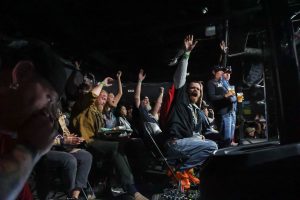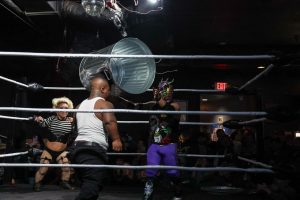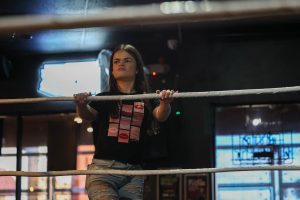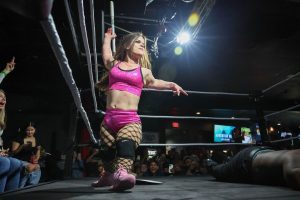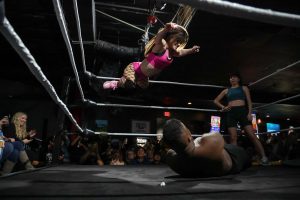- Slug: Sports-Controversial Wrestling Tour 1,500 words
- 13 photos available.
By Aaron Decker
Cronkite News
PHOENIX – The metal trash can lid collides with the wrestler’s head, delivering a resounding “clang” and toppling the man to the mat. His opponent looks out into the crowd, absorbing the cheers and boos from the hundreds of fans surrounding the ring that rests in the middle of a bar floor. The room turns warm, and emits an aroma of draft beer, liquor and buffalo wings. They have packed into the Phoenix bar to see the wrestling tour that brandishes its name on the ringside banner, The Micro Mania Tour.
The wrestling tour travels the country with a roster of competitors who are primarily people with dwarfism. The show presents an entertaining night of wrestling, comedy and even singing before organizers tear down the ring, throw equipment in a van and drive to the next show.
The Micro Mania Tour is one of a few traveling wrestling tours that promote wrestlers with dwarfism, but it is unique in that it proudly advertises itself as “midget wrestling” and openly challenges the idea that the word “midget” is derogatory. The tour’s merchandise uses the word, and its ringside banner proclaims “Midget Lives Matter.” The tour’s organizer, Billy Blade, has said that the goal is to make the word midget great again and turn the perceived insensitive word on its head.
“I look at it like (this): I could walk up to you and be like, ‘You want to go watch little people wrestle?’ or I could walk up to you like, ‘Oh my god, you want to go watch midget wrestling?’ You’re going to be more excited and it’s telling you what you’re about to go see,” wrestler Tiffany Payne said.
The relationship between little people and the language used to refer to them is closely tied to the performative expectations many little people have faced through most of history. It is because of this that tours like the Micro Mania Tour and others, even ones that use less derogatory language, are under the spotlight, having to find the balance between exploitation and fair opportunity.
Little People of America, the largest advocacy group for people in the United States with dwarfism, has opposed these wrestling tours for multiple reasons but singles out the exploitation and health concerns of the performers.
“It’s not just the words that are used,” said Eileen Norman, the president of Little People of America. “It’s the marginalization that comes from the crowd.”
Her group released a statement regarding the Discovery Channel’s reality television series “Big Little Brawlers,” which follows the tour of the Micro Wrestling Federation.
“Little people have been used as entertainment for average-height audiences for hundreds of years: circus ‘freak shows,’ ‘midget-’ or ‘micro-’ wrestling, and dwarf tossing are just a few examples,” an excerpt from the statement said. “Today, most members of our community are strongly opposed to this type of ‘entertainment’ precisely because it is exploitative and, therefore, distasteful.
“Representation matters, and it is important to include diverse stories; however, this one-sided reality show, hailing ‘micro’ wrestling as a hero story for the dwarfism community, is not of any value to the disability community nor young kids with dwarfism looking for mentors. In actuality, it fuels demand for local venues to host events like these in our own communities and subjects little people in those communities to harassment, stalking, and physical assault when viewers inevitably are unable to separate performance from real life.”
The LPA’s concern over promotion of these wrestling events extends to the overall safety of little people. In its statement, it cites the injury and death of Martin Henderson, who was picked up by an English rugby player and then dropped, causing Henderson to be partially paralyzed and to die from his injuries a few years later. The rugby player had recently attended a dwarf tossing event, which blurred the line of acceptable behavior with a little person, the LPA said.
Despite these concerns, many of the wrestlers in the Micro Mania Tour are living the dream of competing as a professional wrestler, something many have wanted to do since they were young. Daniel Graves, a prolific wrestler on the Micro Mania Tour who goes by his ring name, “25 Cent,” has appeared in multiple shows, including “Barstool Sports’ Rough N’ Rowdy” boxing event. Graves said wrestling allows him to follow his passions, make his parents proud and experience a dream come true.
“I respect (the LPA) with all my heart, all my soul, but they’re not going to stop what I like to do,” Graves said.
Other wrestlers say they enjoy the ability to entertain audiences across the country in ways that, yes, may be offensive or derogatory but present a good time for the crowd.
“We sell out almost every night. It’s so many people and they love it and they’re so happy and they laugh,” said Bridget Powers, also known as “Bridget the Midget.” “That’s why I do it, because I like to see everyone smile.”
Bridget relates the wrestling shows to going to a comedy show or watching “Family Guy.” Just like some comedy shows, a crowd may watch or hear something crazy or obscene. Having a sense of humor is needed, she said.
The shows do lean on the side of comedic performance more than high-flying wrestling. For the most part, wrestlers use an array of props like trash can lids or plungers on each other, finding “creative” ways to use them.
At the end of the night, a raffle winner is given the opportunity for one of the wrestlers to hit them in the head with a trash can lid, although on this particular night, the raffle winner opted to bring a woman he knew inside the ring instead. In place of her head, the wrestlers used the lid against her backside. Before she left the ring, she consented to another game with an inappropriate name in which she stood against the turnbuckles as a wrestler pantomimed a sexual motion near her.
Even though the fan didn’t protest or display uncomfortability, as the show seemed to slip away from comedy and more toward shock, it did raise questions about bits that hinted at exploitation of its performers.
Before the show begins, Lil Dynamite and Bridget the Midget stand on the side of the ring and take photos with the audience. A large line forms and fans are encouraged to tip the two wrestlers. Throughout the next 20 minutes, they take traditional photos but also some where fans lift them up.
Critics say that while the wrestlers are agreeing to the poses and getting paid, consent can be a muddied line when financial gain plays a factor.
The word “midget” has always been a way to bring attention to little people and intrigue audiences. In the mid-18th century, opportunities for little people were limited, resulting in many joining traveling shows that showcased an array of disabilities. Labeled as “Freak Shows,” little people were paid to display themselves to curious onlookers. In Robert Bogdan’s book “Freak Show: Presenting Human Oddities for Amusement and Profit,” he labeled these events as “pornography of disability.”
To stir up curiosity for these showcases, the organizers would associate the performers with animalistic qualities. A performer with excessive body hair became a wolf boy or monkey girl. One performer with dwarfism, Samuel Parks, was noted as “Hopp, The Fearless Frog Boy.” But unilaterally, almost every little person was labeled as a midget. The term comes from “midge,” which is a small fly.
Fans that came out to see the show in Phoenix shared multiple perspectives of why they went to see the show. One member of the crowd, Richard Rios, 53, of Mesa, said, “It looked like it could be funny. And why not since there is so much depressing stuff going on in the world.”
Another, who called himself just Fernando, came with his kids for “comedy” and “some violence.”
Wrestlers on the tour have different opinions of the word “midget.” Bridget the Midget uses it as her brand and embraces it, while Payne chooses to leverage it for attracting attention to the show but prefers for people to respect her and call her by her name outside of the show.
Joycelynn Parr, or “Lil Dynamite” as she is known on the roster, doesn’t view using the word as some type of reclaiming of the language or empowering but accepts that it is an element that surrounds her. Most importantly, she views the discussion of the word to be decided and owned by other little people.
“I think that if anybody has anything to say about the word midget, it’s the midgets, and when you walk up to a midget and the midgets (are) OK with that word, then it should be OK,” Parr said.
Not every tour that utilizes primarily little people wrestlers are the same. Others aim for more family friendly angles, while others do embrace a more adult and comedic side.
The discussion about what is right or wrong about these shows will likely continue as long as there is a bar room to fill and audiences to entertain.
For more stories from Cronkite News, visit cronkitenews.azpbs.org.
